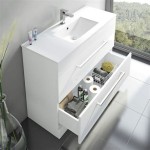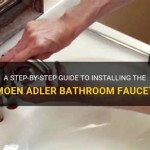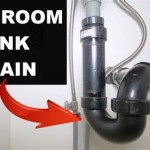Removing a Bathroom Sink Stopper: A Comprehensive Guide
The bathroom sink stopper, while a seemingly simple component, plays a crucial role in retaining water for various tasks, such as shaving, washing hands, or cleaning small items. However, it can also become a source of frustration when it malfunctions, becomes clogged with hair or debris, or requires removal for cleaning or repair. Understanding the different types of stoppers and the methods for removing them is essential for homeowners and maintenance professionals alike.
Several designs of bathroom sink stoppers exist, each with its own unique mechanism for operation and removal. The most common types include lift-rod stoppers, pop-up stoppers, push-and-seal stoppers, and twist-and-turn stoppers. Familiarizing oneself with the specific type installed in the sink is the first step towards successful removal. Incorrectly manipulating the stopper can potentially damage the mechanism or the surrounding plumbing fixtures.
Before attempting any removal procedure, preparation is paramount. Gathering the necessary tools and materials will streamline the process and prevent unnecessary delays. Common tools that may be required include pliers (both slip-joint and needle-nose), a small bucket or container, a flashlight, a screwdriver (Phillips and flathead), and penetrating oil. Additionally, having a pair of gloves is recommended to protect hands from dirt and grime accumulated within the drain assembly.
Safety should be a primary concern throughout the removal process. Turning off the water supply to the sink is crucial to prevent accidental flooding or water damage. The shut-off valves are typically located under the sink, connected to the hot and cold water supply lines. Turning both valves clockwise will effectively cut off the water flow. Placing a bucket under the drain assembly is also advisable to catch any residual water or debris that may be present.
Identifying the Stopper Type and Its Mechanism
The first step in removing a sink stopper is accurately identifying its type. The most common type, the lift-rod stopper, is characterized by a vertical rod located behind the faucet. This rod connects to a horizontal pivot rod that controls the movement of the stopper within the drain. Pop-up stoppers are generally controlled by a mechanism located on the drain pipe itself. These stoppers often have a small cap that can be pressed to open and close the drain. Push-and-seal stoppers, as the name suggests, operate by pushing down on the stopper to seal the drain and pushing again to release it. Twist-and-turn stoppers feature a cap that needs to be twisted to lock and unlock the drain.
Understanding the mechanism behind each type is crucial for determining the appropriate removal technique. For example, attempting to force a lift-rod stopper out without disconnecting the pivot rod can damage the linkage or the stopper itself. Similarly, trying to pry out a push-and-seal stopper without understanding its locking mechanism could result in breakage.
Visual inspection is key to identifying the stopper type. A close examination of the stopper's surface and the surrounding hardware will usually reveal clues about its operating mechanism. Online resources, such as manufacturer websites or plumbing forums, can also provide valuable information and diagrams specific to different stopper types.
Removing a Lift-Rod Stopper
Removing a lift-rod stopper requires disconnecting the pivot rod located beneath the sink. Begin by locating the pivot rod, which is connected to the lift rod via a clevis or spring clip. This clip needs to be detached, allowing the pivot rod to be separated from the lift rod mechanism. In some cases, the clip may be secured with a small screw, which will need to be loosened before the clip can be removed.
Once the clevis or spring clip is detached, the pivot rod can be carefully removed from the drain assembly. It is important to note the orientation of the pivot rod before removing it, as this will aid in reassembly later on. With the pivot rod removed, the stopper should now be free to be lifted out of the drain. If the stopper is stuck, gently twist and wiggle it while applying upward pressure. Avoid using excessive force, as this could damage the stopper or the drain assembly.
After the stopper is removed, thoroughly clean it to remove any accumulated hair, soap scum, or debris. A stiff brush and a mild cleaning solution can be used for this purpose. Inspect the stopper for any signs of damage, such as cracks or wear, and replace it if necessary. Before reassembling the lift-rod mechanism, ensure that the pivot rod is also clean and free of debris. Apply a small amount of plumber's grease to the pivot rod to ensure smooth operation.
Removing a Pop-Up, Push-and-Seal, or Twist-and-Turn Stopper
While the lift-rod stopper is relatively complex to remove, pop-up, push-and-seal, and twist-and-turn stoppers are often simpler. Pop-up stoppers typically have a cap that can be unscrewed or pried off. Some models may have a small set screw that needs to be loosened before the cap can be removed. Once the cap is removed, the stopper assembly can be lifted out of the drain. If the stopper is stuck, gently twist and wiggle it while applying upward pressure.
Push-and-seal stoppers usually require a different approach. Some models can be simply pulled out after pushing down on them to release the internal locking mechanism. Other models may require a slight twist before they can be pulled out. Consult the manufacturer's instructions or search online for specific instructions related to the particular model of push-and-seal stopper.
Twist-and-turn stoppers are removed by twisting the cap to the unlocked position and then lifting the stopper out of the drain. Some models may have a small set screw that needs to be loosened before the stopper can be removed. Similar to other types of stoppers, gentle twisting and wiggling while applying upward pressure may be necessary if the stopper is stuck.
Once any of these types of stoppers are removed, thorough cleaning is essential. Use a brush and cleaning solution to remove any accumulated debris. Inspect the stopper for damage and replace it if necessary. Ensure that the drain opening is also cleaned to prevent future clogs. A simple baking soda and vinegar mixture can be used to flush out the drain and remove any lingering buildup.
Reinstallation of these stoppers is typically straightforward. Simply insert the stopper into the drain and follow the reverse of the removal procedure to secure it in place. For pop-up stoppers, ensure that the cap is properly screwed on or secured with the set screw. For push-and-seal stoppers, ensure that the locking mechanism is properly engaged. For twist-and-turn stoppers, ensure that the cap is properly aligned and twisted to the locked position.
Maintaining the stopper and drain system is crucial for preventing future clogs and ensuring proper drainage. Regularly cleaning the stopper and drain with a baking soda and vinegar mixture can help to dissolve hair and soap scum before they accumulate and cause problems. Using a drain strainer can also help to catch hair and other debris before they enter the drain.
In situations where the stopper is severely stuck or damaged, it may be necessary to call a professional plumber. Attempting to force a stuck stopper or repair a damaged stopper without the proper tools and expertise can potentially damage the drain assembly or surrounding plumbing fixtures. A plumber can safely remove the stopper and repair any underlying issues with the drain system.

How To Remove A Bathroom Sink Stopper Take Out Pop Up Drain From

How To Remove A Sink Stopper The Home Depot

How To Replace A Sink Stopper Quick And Simple Home Repair

How To Remove A Sink Stopper The Home Depot

Quick Tip 26 Pop Up Stopper Sticks Misterfix It Com

How To Replace Bathroom Sink Stopper Avg Cost 25 65 1 2hrs

How To Remove A Sink Stopper Quick Easy Guide

9 Easy Steps To Remove A Bathroom Sink Stopper With Pictures

How To Remove A Sink Stopper The Home Depot

How To Remove A Sink Stopper Service Champions
Related Posts







